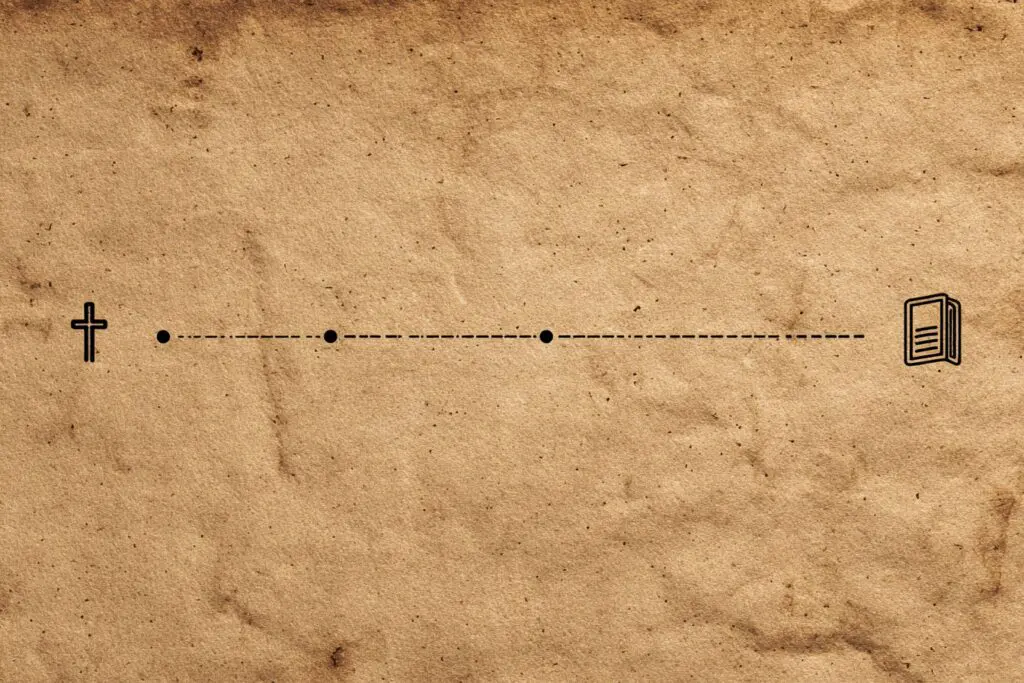I was having coffee with a friend the other day, and we somehow got onto the topic of old books. Not just dusty library books, but really old books. It made me wonder about the Bible. For something that has shaped so much of the world, I realized I had a pretty fuzzy idea of its origins. It’s not like someone was following Jesus around with a notepad, right? So, how long after Jesus died was the Bible written? The answer isn’t a simple number, and diving into it felt like unraveling a historical mystery. It turns out, there’s a surprising gap.
More in Bible Category
How Long Did It Take to Write the Bible
Is the New Living Translation Bible Accurate
Key Takeaways
- Not Written Immediately: The New Testament wasn’t written while Jesus was alive or right after he died. There was a significant period of oral tradition first.
- First Writings (Paul’s Letters): The earliest Christian writings are the letters of the Apostle Paul, starting around 48-50 AD, which is roughly 15-20 years after Jesus’s death.
- The Gospels Came Later: The four Gospels (Matthew, Mark, Luke, and John), which tell the story of Jesus’s life, were written later. Mark is generally considered the first, written around 65-70 AD (about 35-40 years after). John was the last, around 90-100 AD.
- It Was a Process: The New Testament wasn’t created as a single book. It’s a collection of 27 different documents (letters, gospels, history, and apocalypse) written by various authors over about 50-60 years.
- The Old Testament is Much Older: It’s crucial to remember the “Bible” includes the Old Testament, which consists of Jewish scriptures written over centuries, long before Jesus was even born.
So, No One Wrote Anything Down Right Away?
That was my first question. It seems strange, doesn’t it? If you’d just witnessed something incredible, wouldn’t your first instinct be to write it all down? But you have to put yourself in their shoes. I can barely remember what I had for breakfast last Tuesday, let alone recall detailed conversations from years ago.
For the early followers of Jesus, writing wasn’t the immediate priority. They were living in a culture that had a very strong oral tradition. Stories, teachings, and histories were passed down by word of mouth, and people’s memories were trained for it in a way ours, with our constant note-taking apps, just aren’t.
More importantly, they believed Jesus was coming back—soon. They thought the world as they knew it was about to end. When you’re expecting the end of the world any day now, you’re not thinking about creating a religious text for future generations. You’re focused on spreading the message to as many people as possible, and the fastest way to do that was by talking.
Why Did They Finally Start Writing?
So what changed? A few things. As time went on, the original apostles and eyewitnesses started to get old and pass away. The community realized that if they didn’t get these stories written down, they could be lost or distorted forever.
Also, the Christian movement was spreading like wildfire across the Roman Empire. With communities popping up in different cities, written documents became essential for a few reasons:
- Consistency: To ensure everyone was getting the same message.
- Instruction: To teach new converts about the life and teachings of Jesus.
- Guidance: To address specific problems and questions that were coming up in different churches.
This is where the first writings of the New Testament come in—not the stories about Jesus, but letters from his followers.
The First Words: Paul’s Postcards
It’s a bit of a surprise, but the first things written that ended up in our New Testament weren’t the Gospels. They were letters, mostly from a man named Paul. Paul was a fascinating character; he never met Jesus when he was alive. He was originally a persecutor of Christians before having a dramatic conversion experience.
So, Who Was This Guy and Why Were His Letters So Important?
Paul traveled around the Mediterranean starting new Christian communities. After he left a town, he’d write letters back to them. These weren’t grand theological treatises meant to be “scripture.” They were real letters to real people dealing with real problems. Think of them as a mix of encouragement, scolding, advice, and theological discussion.
He was writing to the church in Corinth about their chaotic worship services, to the Galatians about arguments over religious law, and to his friend Philemon about a runaway slave. Because they were written to address immediate needs, they are our earliest window into the life of the early church.
The earliest of these letters, like 1 Thessalonians, are dated to around 48-50 AD. If we date Jesus’s death to around 30-33 AD, that means the first Christian writings we have are from about 15 to 20 years later. That’s still a gap, but it’s getting smaller.
Okay, But What About the Actual Story of Jesus? The Gospels
This is the part most people think of when they ask, “How long after Jesus died was the Bible written?” The four Gospels—Matthew, Mark, Luke, and John—are our primary sources for the life, teachings, death, and resurrection of Jesus. And they came along a bit later than Paul’s letters.
Most scholars believe the Gospel of Mark was the first one written. It’s short, punchy, and gets straight to the action.
When Was Mark Written?
The dating is usually placed somewhere between 65 and 70 AD. That’s a solid 35 to 40 years after the events happened. This timing isn’t random. This was a traumatic period for the Jewish people, including the early Jewish Christians. The Roman-Jewish war was raging, and in 70 AD, the Romans destroyed the Temple in Jerusalem, the center of Jewish life. It was a world-ending event.
Imagine living through something like that. It would feel like the sky was falling. It’s in this chaotic, desperate environment that someone—we traditionally call him Mark—decides it’s time to write down the story of Jesus. He’s writing for a community under stress, likely in Rome, reminding them of the power and suffering of Jesus.
What About Matthew and Luke?
Matthew and Luke are generally dated a bit later, maybe around 80-90 AD. It’s pretty clear to scholars that both of these authors had a copy of Mark’s Gospel in front of them when they were writing. They use a lot of his material, sometimes word for word.
But they also add their own unique stuff.
- Matthew: Seems to be writing for a more Jewish-Christian audience, emphasizing how Jesus fulfilled Old Testament prophecies. He includes the Sermon on the Mount and other large blocks of teaching.
- Luke: Also the author of the Book of Acts, Luke presents a more universal story, emphasizing Jesus’s concern for the poor, women, and non-Jews. He includes stories like the Good Samaritan and the Prodigal Son that aren’t found anywhere else.
They also seem to have shared another source that Mark didn’t have—a collection of Jesus’s sayings, which scholars have nicknamed “Q” (from the German word Quelle, meaning “source”). We don’t have a copy of Q, it’s just a theory, but it helps explain all the parallel material in Matthew and Luke that isn’t in Mark. For more on this, you can explore the resources at Duke University’s Divinity School.
And John? He Seems a Bit Different.
If you’ve ever read the Gospels, you know John stands apart. The language is different, the stories are different, and the timeline is a bit different. It’s more poetic, more philosophical.
John’s Gospel is the last one, written somewhere between 90 and 100 AD, maybe even a little later. We’re now talking 60 to 70 years after Jesus. The author was writing for a community that had spent decades thinking about who Jesus was, and his Gospel reflects that deeper, more developed theology. He’s not just telling you what Jesus did; he’s telling you what it means.
So, We’re Talking a Lifetime Later? How Can We Trust It?
This is the big, skeptical question, isn’t it? If the story wasn’t written down for 30, 40, or even 60 years, how much of it is real? It’s a fair question. I mean, my memory of college, which was only a decade ago, is already getting hazy on the details.
But a few things are worth considering.
Community Memory vs. Individual Memory
We’re not talking about one guy trying to remember something by himself. The stories of Jesus were told and retold constantly in communities. They were part of their worship, their teaching, and their identity. Think of it like a family’s stories. You know, the one about how your grandpa did that hilarious thing at a wedding? Everyone in the family knows that story. If one person tells it wrong, an aunt or a cousin will jump in and say, “No, that’s not how it happened!”
The core facts of the story were preserved by the community. While smaller details might have been framed differently by each Gospel writer for their specific audience, the main narrative—Jesus’s teachings, his crucifixion by the Romans, and the belief in his resurrection—was fixed pretty early on.
This Isn’t Like a Game of “Telephone”
The “telephone game” analogy, where a message gets hopelessly garbled as it’s passed along, doesn’t really fit. That game is about whispering a secret message one time. Oral tradition in the ancient world was about publicly and repeatedly telling important stories. There were recognized leaders and teachers—the apostles and their disciples—who were seen as the authoritative guardians of these traditions. It wasn’t a free-for-all.
Putting It All Together: From Stories to a Book
So we have all these separate documents—Paul’s letters, four different Gospels, a history book (Acts), other letters (like James and Peter), and an apocalypse (Revelation)—all written between roughly 50 AD and 100 AD.
But that still isn’t the “Bible” as we know it. For centuries, different churches had different collections of books they considered authoritative. Some included books that didn’t make the final cut, and others didn’t have books that did.
It took a long process of debate and use over about 300 years for the church to largely agree on the 27 books that make up our New Testament today. It wasn’t until a letter written by a bishop named Athanasius in 367 AD that we see the first complete list of the 27 books that exactly matches our current New Testament.
So, the answer to “How long after Jesus died was the Bible written?” is complicated.
- The first writings were about 15-20 years after.
- The story of his life was first written down about 35-40 years after.
- The whole collection of writings was completed by about 60-70 years after.
- The final, official list of books wasn’t settled for over 300 years.
Far from being a single book dropped from the sky, the New Testament is a library of human documents written by real people in real historical situations. For me, knowing this doesn’t diminish it. It makes it more fascinating—a collection of voices reaching across a lifetime, trying to capture the meaning of an event that changed their world.
Frequently Asked Questions – How Long After Jesus Died Was the Bible Written

How were the New Testament books finalized, and how long did it take?
The New Testament was completed within about 60 years after Jesus’s death, with all books written by apostles or their close friends, including Paul’s letters, the Gospels, and the book of Revelation, showcasing a Spirit-led, carefully preserved process.
Why do the timing and process of writing the Bible strengthen its trustworthiness?
The relatively short time span—about 60 years from Jesus’s death to the completion of the New Testament—and the presence of eyewitnesses ensured the accuracy and reliability of the writings.
Who wrote the earliest Gospel, and when was it written?
Most experts believe that Mark wrote the earliest Gospel, likely between 65 and 70 AD, offering a direct account of Jesus’s life based on Peter’s firsthand stories.
How long after Jesus’ death were the earliest books of the New Testament written?
The earliest writings, Paul’s letters, were composed around 15 to 20 years after Jesus’ death, between 48 and 50 AD, while the Gospels were written 30 to 40 years later.
Why didn’t the early Christians write down the New Testament right after Jesus’ death?
The early Christians prioritized oral storytelling because their culture valued spoken words as true and they believed Jesus would return soon, so they focused on preaching rather than writing.




